Project1-ns3 模拟数据中心
实验要求
根据上面的数据中心拓扑图,完成以下要求:
1. 根据给定的数据中心的拓扑结构,利用 ns3 进行仿真
2. 模拟两种通信模式(traffic pattern)
o all-to-all:每个服务器都发送消息给其他服务器消息,由拓扑结构可知,超过 50%的消息
传送将跨越两个簇(cluster)
o many-to-one:每个服务器都发送消息给其中一个服务器
3. 测量两种模式下网络的仿真可以达到的吞吐量,找出网络瓶颈,并且说明如何改进
注:拓扑中的网络都是 Ethernet 网
�
实验内容
数据中心模拟
①实现及主要代码解释
a. 设置自定义的 attribute
为了做实验方便,设置如下自定义 attribute:
pattern:通信模式,all-to-all 或 many-to-one,默认为 1
defaultDst:多对一模式下,接收消息的默认服务器序号,默认为 0
verbose:enable 或者 disable PacketSink 和 OnOffApplication 的日志,默认为 false
DataRate1:定义数据中心拓扑第一层的数据传输速率(Mbps),默认为 1.0
DataRate2:定义数据中心拓扑第二层的数据传输速率(Mbps),默认为 1.0
DataRate3:定义数据中心拓扑第三层的数据传输速率(Mbps),默认为 1.5
实现代码如下:
uint16_t pattern = 1;
uint16_t nodesNum = 8;
uint16_t defaultDst = 0;
float DataRate1 = 1.0;
float DataRate2 = 1.0;
float DataRate3 = 1.5;
uint16_t port = 50000;
bool verbose = false;
CommandLine cmd;
cmd.AddValue("pattern", "number of traffic pattern",
pattern);//pattern1:all-to-all pattern2:many-to-one
cmd.AddValue("defaultDst", "default destination server node in pattern
2", defaultDst);
�
cmd.AddValue("DataRate1", "data rate of csma network at level 1",
DataRate1);
cmd.AddValue("DataRate2", "data rate of csma network at level 2",
DataRate2);
cmd.AddValue("DataRate3", "data rate of csma network at level 3",
DataRate3);
cmd.AddValue ("verbose", "Tell sink and onoff applications to log if
true", verbose);
cmd.Parse(argc, argv);
LogComponentEnable ("DataCenterSimulation", LOG_LEVEL_INFO);
if (verbose)
{
}
LogComponentEnable ("PacketSink", LOG_LEVEL_INFO);
LogComponentEnable ("OnOffApplication", LOG_LEVEL_INFO);
b. 创建结点
根据实验要求,总共需要创建 15 个结点,包括:
8 servers
4 ToR switches
2 Aggregation switches
1 Core switch
实现代码如下:
//create nodes
NodeContainer n1_8;
n1_8.Create(8);
NodeContainer t1_4;
t1_4.Create(4);
NodeContainer a12;
a12.Create(2);
NodeContainer c1;
c1.Create(1);
�
c. 创建 CSMA 网络节点
整个数据中心网络拓扑从下往上可以分为三层,即
第一层:由服务器与 ToR 组成的 ethernet 网络,共有 4 个,编号为
CSMA11,CSMA12,CSMA13,CSMA14
第二层:由 ToR 与 Aggregation 组成的 ethernet 网络,共有 2 个,编号为 CSMA21,CSMA22
第三层:由 Aggregation 与 Core 组成的 ethernet 网络,共有 1 个,编号为 CSMA3
将创建好的 15 个网络结点分配到这 7 个 CSMA 网络中,实现代码如下:
//create csma nodes
NodeContainer csmaNodes11 =
NodeContainer(n1_8.Get(0),n1_8.Get(1),t1_4.Get(0));
NodeContainer csmaNodes12 =
NodeContainer(n1_8.Get(2),n1_8.Get(3),t1_4.Get(1));
NodeContainer csmaNodes13 =
NodeContainer(n1_8.Get(4),n1_8.Get(5),t1_4.Get(2));
NodeContainer csmaNodes14 =
NodeContainer(n1_8.Get(6),n1_8.Get(7),t1_4.Get(3));
NodeContainer csmaNodes21 =
NodeContainer(t1_4.Get(0),t1_4.Get(1),a12.Get(0));
NodeContainer csmaNodes22 =
NodeContainer(t1_4.Get(2),t1_4.Get(3),a12.Get(1));
NodeContainer csmaNodes3
=
NodeContainer(a12.Get(0),a12.Get(1),c1.Get(0));
d. 设置 CSMA 网络 attribute,并将其安装到相应结点上
根据实验要求中的网络拓扑,设置相应网络的属性
所有直接相连的两个结点之间的延迟都为 500ns
第一层和第二层 CSMA 网络的数据传输速率都为 1.0Mbps,第三层为 1.5Mbps
�
然后安装到相应的网络结点上,实现代码如下(DataRate 可以通过命令行参数设置,默认
值即为原实验要求):
//create the channels first without any IP addressing information
CsmaHelper csma1;
sprintf(buf,"%1.1fMbps",DataRate1);
csma1.SetChannelAttribute ("DataRate", StringValue (buf));
csma1.SetChannelAttribute ("Delay", StringValue ("500ns"));
NetDeviceContainer csmaDevices11 = csma1.Install (csmaNodes11);
NetDeviceContainer csmaDevices12 = csma1.Install (csmaNodes12);
NetDeviceContainer csmaDevices13 = csma1.Install (csmaNodes13);
NetDeviceContainer csmaDevices14 = csma1.Install (csmaNodes14);
CsmaHelper csma2;
sprintf(buf,"%1.1fMbps",DataRate2);
csma2.SetChannelAttribute ("DataRate", StringValue (buf));
csma2.SetChannelAttribute ("Delay", StringValue ("500ns"));
NetDeviceContainer csmaDevices21 = csma2.Install (csmaNodes21);
NetDeviceContainer csmaDevices22 = csma2.Install (csmaNodes22);
CsmaHelper csma3;
sprintf(buf,"%1.1fMbps",DataRate3);
csma3.SetChannelAttribute ("DataRate", StringValue (buf));
csma3.SetChannelAttribute ("Delay", StringValue ("500ns"));
NetDeviceContainer csmaDevices3
= csma3.Install (csmaNodes3);
e. 分配网络 IP
根据实验要求,为每个结点安装协议栈,并为 7 个 CSMA 网络分配 IP,实现代码如下
//assign IP address
NS_LOG_INFO ("Assign IP address.");
InternetStackHelper stack;
stack.Install (n1_8);
stack.Install (t1_4);
stack.Install (a12);
stack.Install (c1);
Ipv4AddressHelper address;
address.SetBase ("10.0.1.0", "255.255.255.0");
Ipv4InterfaceContainer csmaInterfaces11 = address.Assign
(csmaDevices11);
address.SetBase ("10.0.2.0", "255.255.255.0");
�
Ipv4InterfaceContainer csmaInterfaces12 = address.Assign
(csmaDevices12);
address.SetBase ("10.0.3.0", "255.255.255.0");
Ipv4InterfaceContainer csmaInterfaces13 = address.Assign
(csmaDevices13);
address.SetBase ("10.0.4.0", "255.255.255.0");
Ipv4InterfaceContainer csmaInterfaces14 = address.Assign
(csmaDevices14);
address.SetBase ("10.1.1.0", "255.255.255.0");
Ipv4InterfaceContainer csmaInterfaces21 = address.Assign
(csmaDevices21);
address.SetBase ("10.2.1.0", "255.255.255.0");
Ipv4InterfaceContainer csmaInterfaces22 = address.Assign
(csmaDevices22);
address.SetBase ("192.168.1.0", "255.255.255.0");
Ipv4InterfaceContainer csmaInterfaces3
= address.Assign
(csmaDevices3);
f. 初始化路由表
这里直接调用了 ns3 自带的路由实现,实现代码如下
// Create router nodes, initialize routing database and set up the
routing
// tables in the nodes.
Ipv4GlobalRoutingHelper::PopulateRoutingTables ();
g. 创建和分配 PacketSink 和 OnOffClient
首先,创建 sink 和 OnOff,实现代码如下
//Create sinkApp and OnOffClient
ApplicationContainer clientApp[nodesNum][4];
ApplicationContainer sinkApp[nodesNum];
然后,分配 sink 到所有的 server 结点上,实现代码如下(其中 nodesNum 表示 server 个数):
for(unsigned int i = 0;i < nodesNum; i++)
{
�
PacketSinkHelper packetSinkHelper ("ns3::TcpSocketFactory",
getAddress(i,port,csmaInterfaces11,csmaInterfaces12,csmaInterfaces13,
csmaInterfaces14));
sinkApp[i] = packetSinkHelper.Install (n1_8.Get (i));
sinkApp[i].Start(Seconds (1.0));
sinkApp[i].Stop(Seconds (60.0));
}
再然后,分配 OnOffClient 到 server 结点上,并且根据 pattern 不同,进行不同的配置
pattern 1:每个服务器都发送消息给其他服务器消息,即发送消息给在另一个簇上面的 4
个服务器(每个服务器上建立 4 个 OnOffClient)
pattern 2:每个服务器都发送消息给同一个服务器,可以默认为 n1(每个服务器(n1 除
外)上建立 1 个 OnOffClient)
实现代码如下
for(int i = 0; i < nodesNum; i++)
{
uint16_t dst = 0;
if(pattern==1){//all-to-all pattern
for(int j = 0 ;j < 4; j++){
if(i<=3)
else
dst = j+4;
dst = j;
OnOffHelper
client("ns3::TcpSocketFactory",getAddress(dst,port,csmaInterfaces11,c
smaInterfaces12,csmaInterfaces13,csmaInterfaces14));
client.SetAttribute ("OnTime",
StringValue("ns3::ConstantRandomVariable[Constant=50]"));
client.SetAttribute ("OffTime",
StringValue("ns3::ConstantRandomVariable[Constant=0]"));
client.SetAttribute ("DataRate", DataRateValue (DataRate
("1.0Mbps")));
client.SetAttribute ("PacketSize", UintegerValue (2000));
clientApp[i][j] = client.Install (n1_8.Get (i));
clientApp[i][j].Start(Seconds (1.0));
clientApp[i][j].Stop (Seconds (51.0));
�
sprintf(buf,"OnOffClient @Node %d aims at Server
@Node %d",i+1,dst+1);
NS_LOG_INFO (buf);
}
}else if(pattern==2){//many-to-one pattern
if(i == defaultDst)continue;
dst = defaultDst;
OnOffHelper
client("ns3::TcpSocketFactory",getAddress(dst,port,csmaInterfaces11,c
smaInterfaces12,csmaInterfaces13,csmaInterfaces14));
client.SetAttribute ("OnTime",
StringValue("ns3::ConstantRandomVariable[Constant=50]"));
client.SetAttribute ("OffTime",
StringValue("ns3::ConstantRandomVariable[Constant=0]"));
client.SetAttribute ("DataRate", DataRateValue (DataRate
("1.0Mbps")));
client.SetAttribute ("PacketSize", UintegerValue (2000));
clientApp[i][0] = client.Install (n1_8.Get (i));
clientApp[i][0].Start(Seconds (1.0));
clientApp[i][0].Stop (Seconds (51.0));
sprintf(buf,"OnOffClient @Node %d aims at Server
@Node %d",i+1,dst+1);
NS_LOG_INFO (buf);
}
这里解释一下一个函数
getAddress:根据 server 的标号产生相应的 IP:port 地址
getAddress 实现代码如下
InetSocketAddress getAddress(int i,uint16_t
port,Ipv4InterfaceContainer i1,Ipv4InterfaceContainer
i2,Ipv4InterfaceContainer i3,Ipv4InterfaceContainer i4){
switch(i){
case 0:
return InetSocketAddress(i1.GetAddress(0),port);break;
case 1:
return InetSocketAddress(i1.GetAddress(1),port);break;
case 2:
�
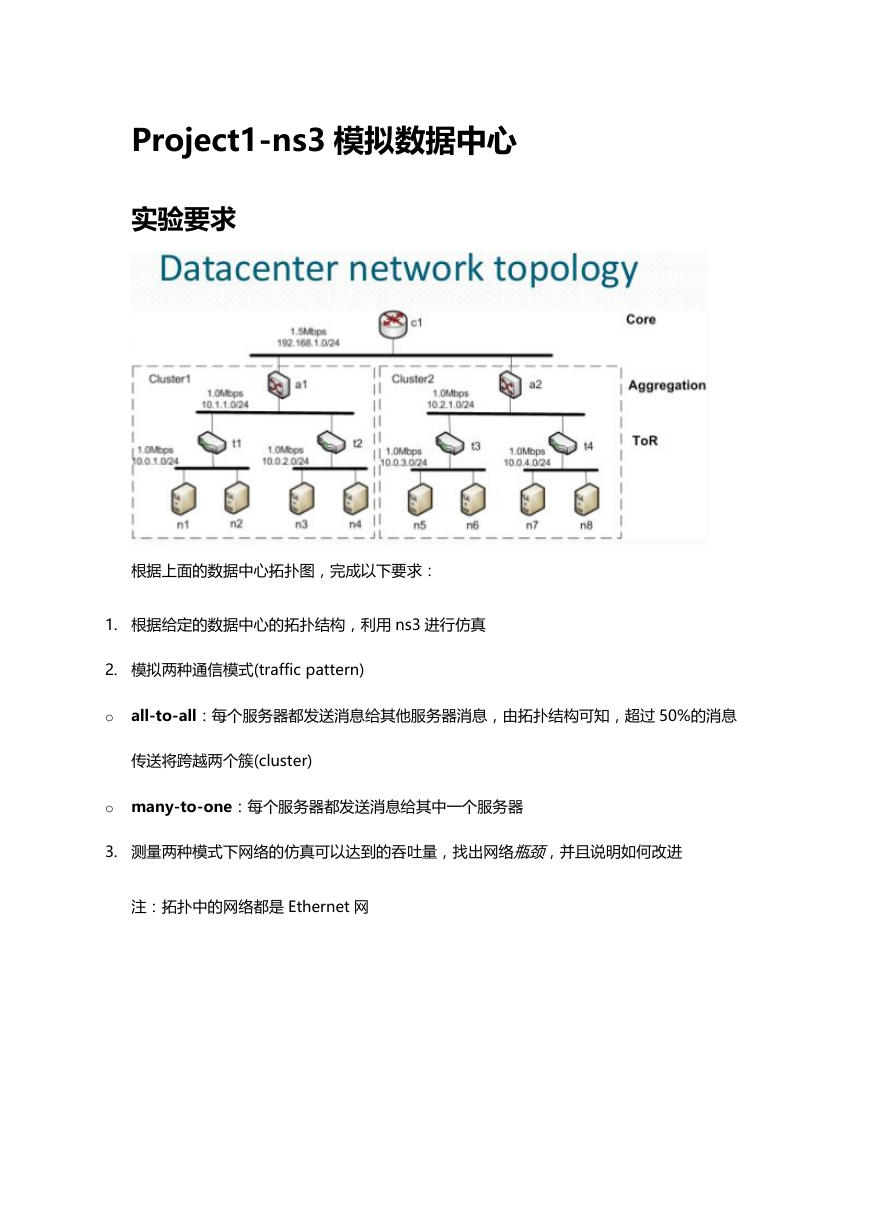
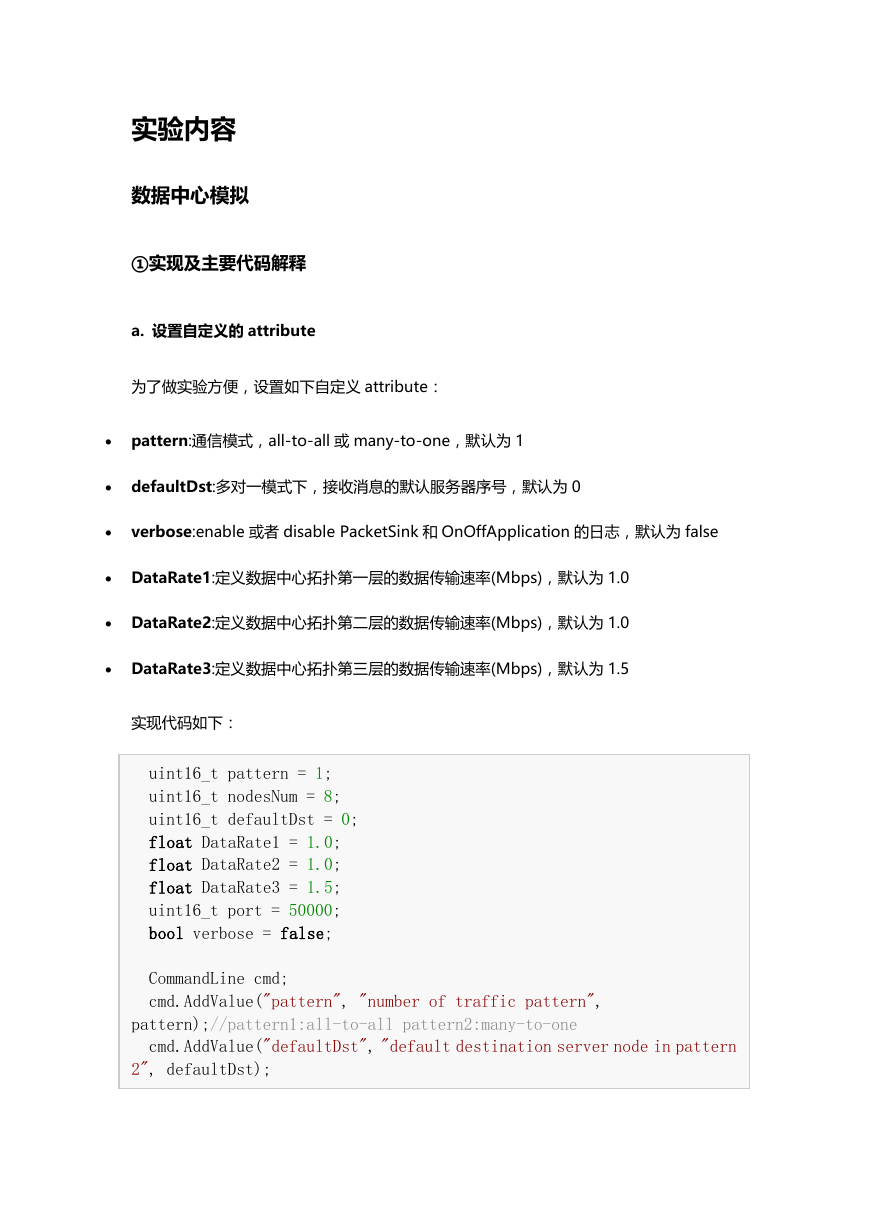
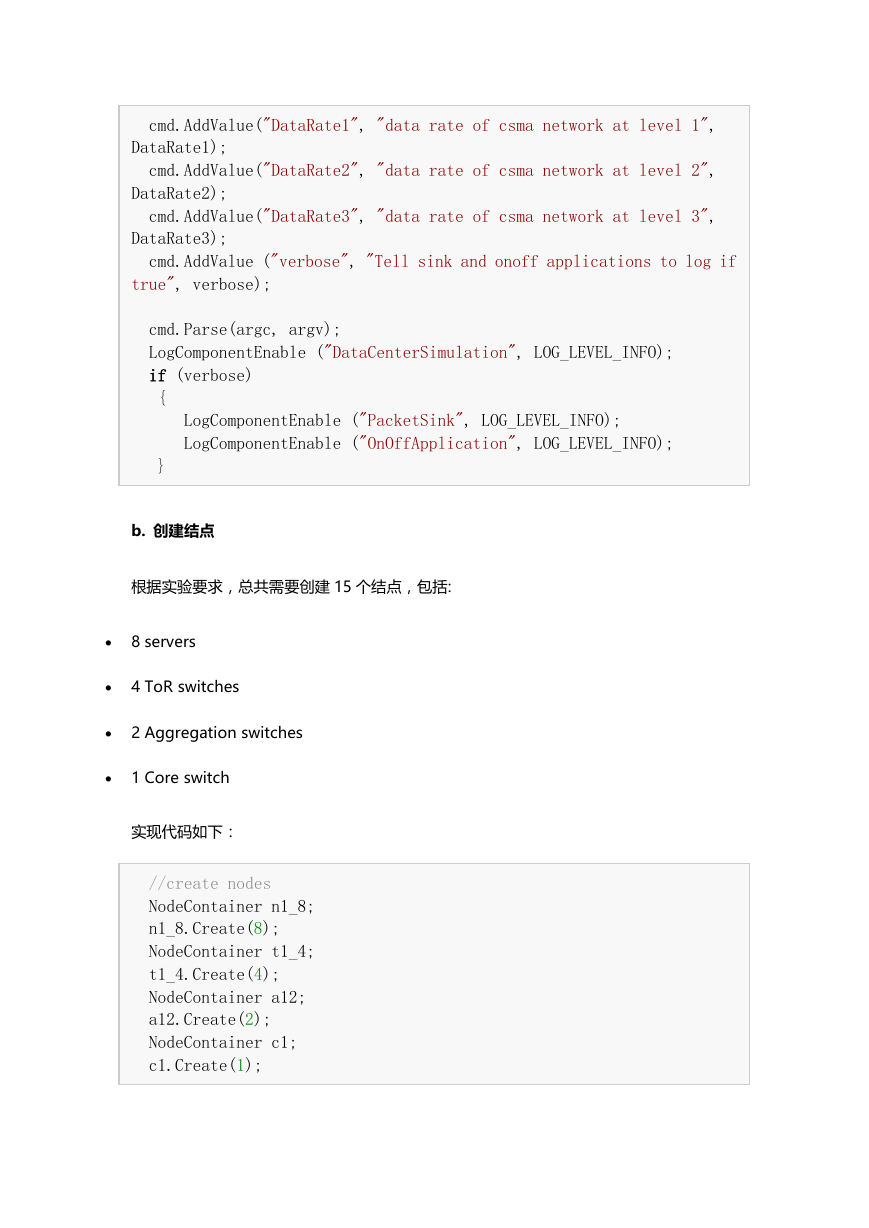
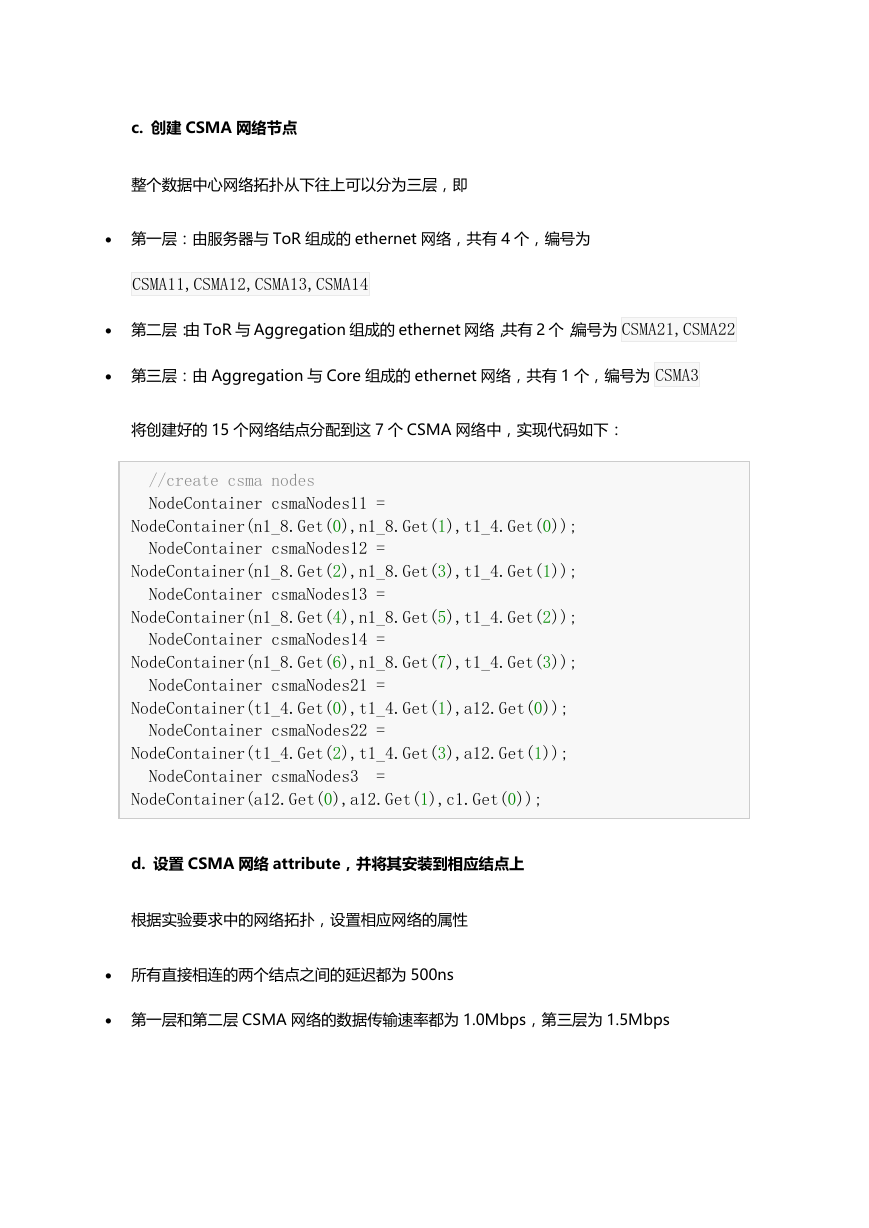
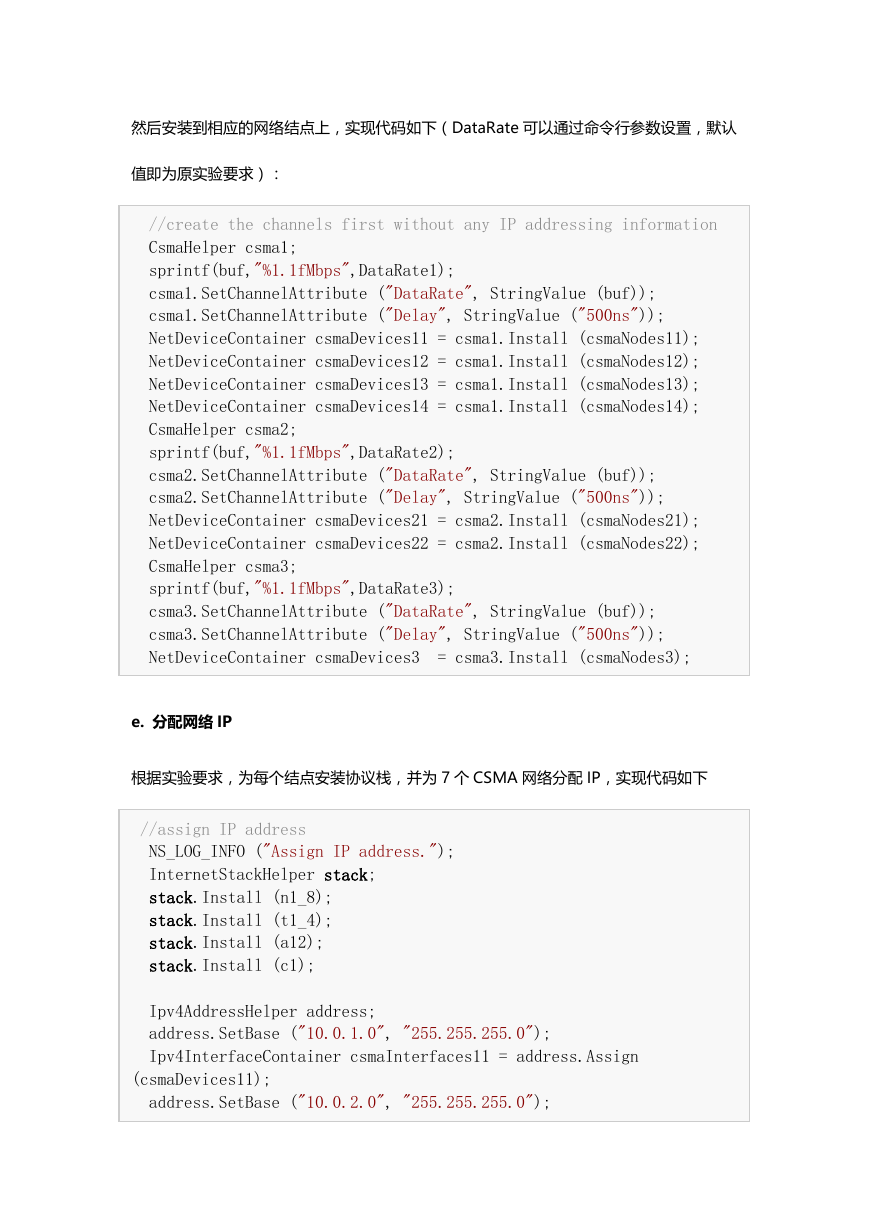
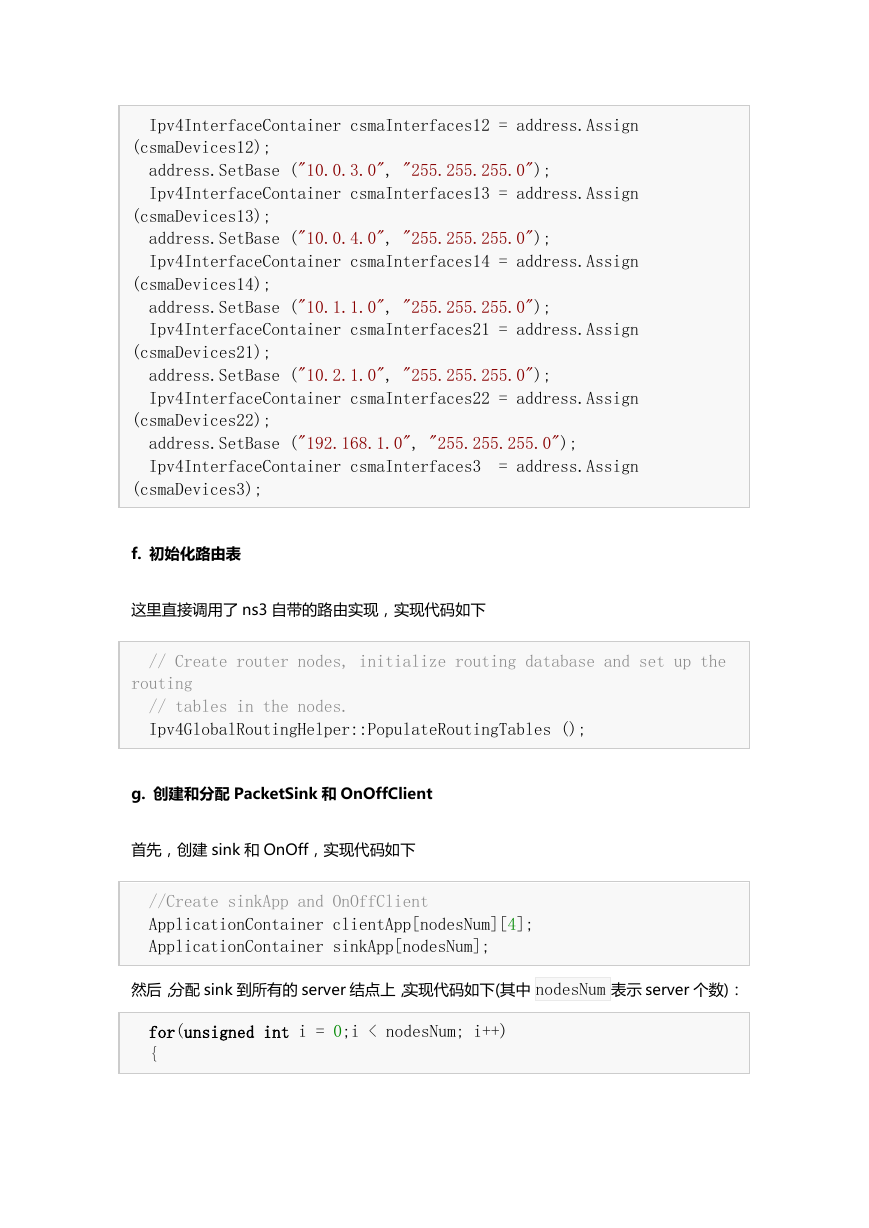
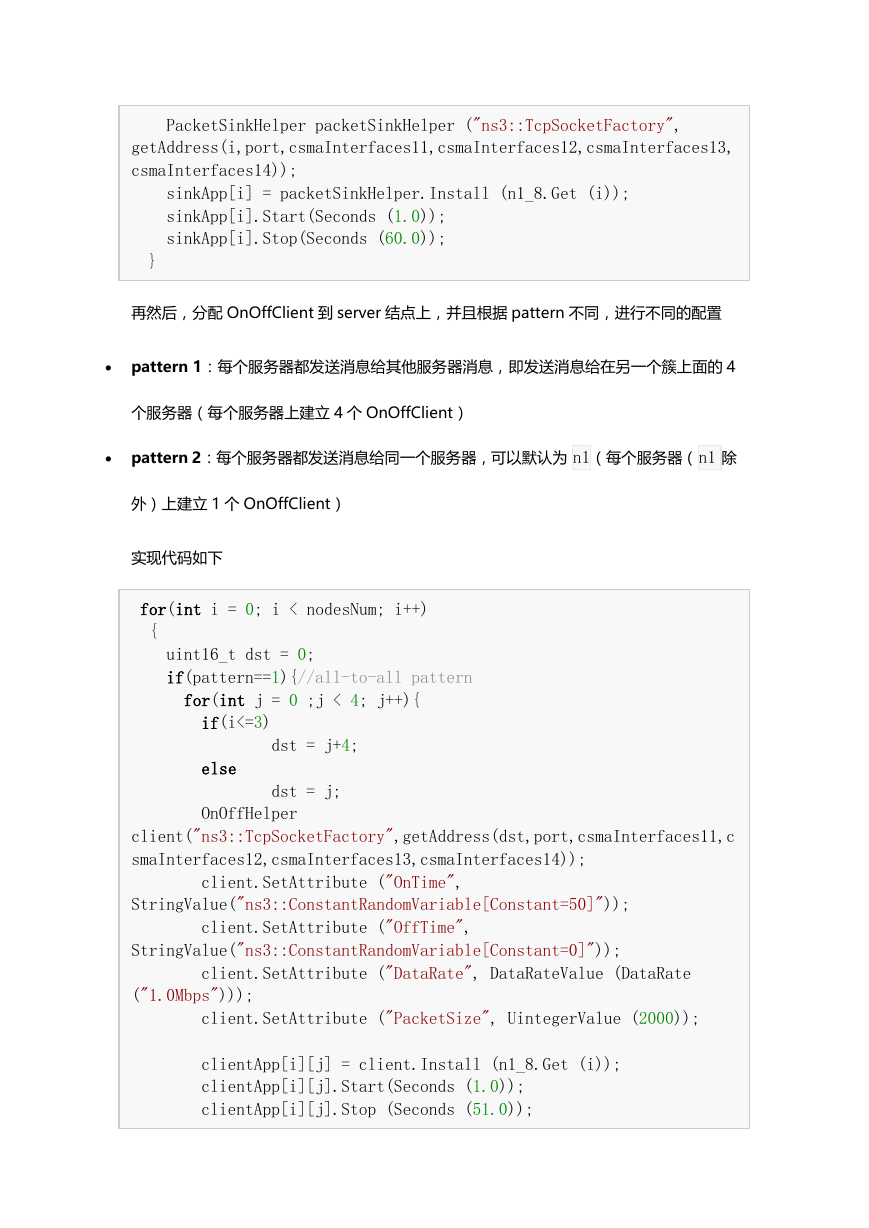
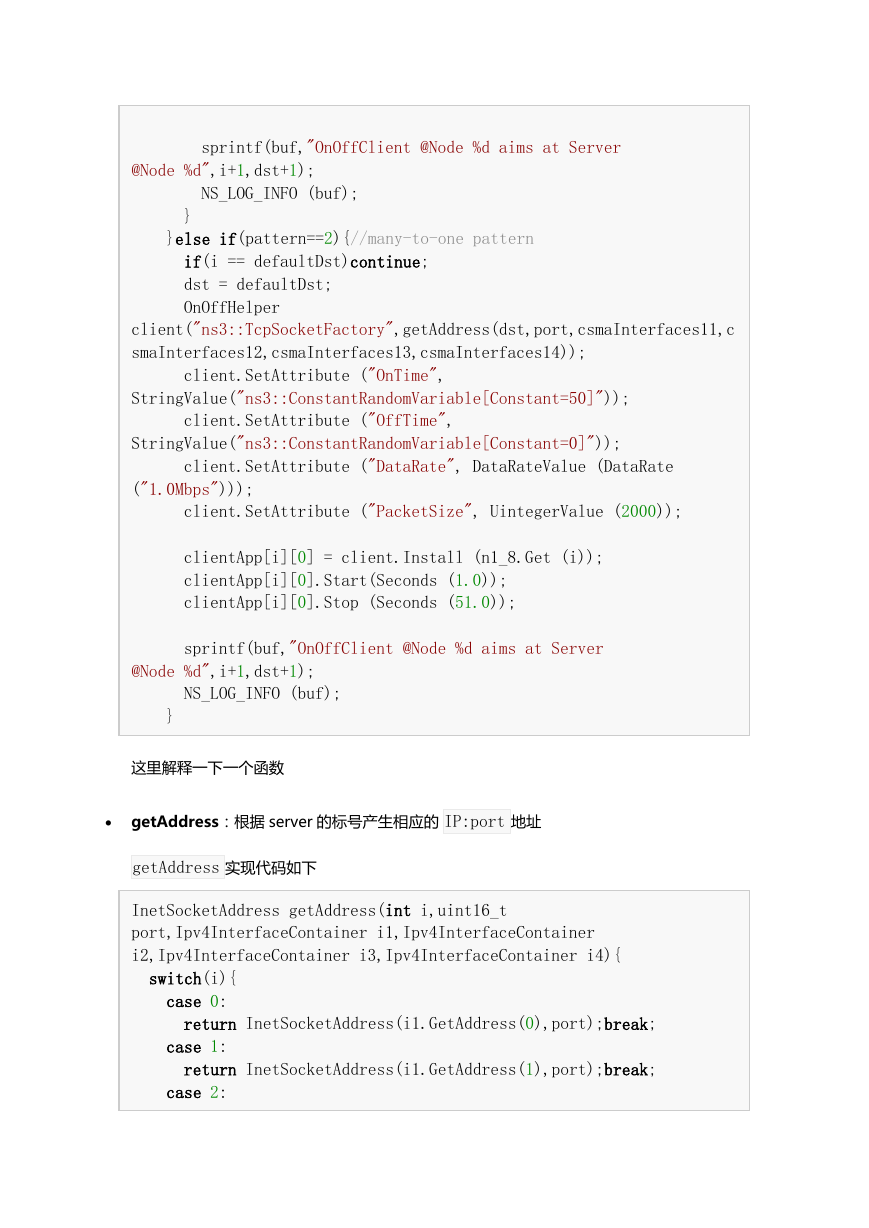








 2023年江西萍乡中考道德与法治真题及答案.doc
2023年江西萍乡中考道德与法治真题及答案.doc 2012年重庆南川中考生物真题及答案.doc
2012年重庆南川中考生物真题及答案.doc 2013年江西师范大学地理学综合及文艺理论基础考研真题.doc
2013年江西师范大学地理学综合及文艺理论基础考研真题.doc 2020年四川甘孜小升初语文真题及答案I卷.doc
2020年四川甘孜小升初语文真题及答案I卷.doc 2020年注册岩土工程师专业基础考试真题及答案.doc
2020年注册岩土工程师专业基础考试真题及答案.doc 2023-2024学年福建省厦门市九年级上学期数学月考试题及答案.doc
2023-2024学年福建省厦门市九年级上学期数学月考试题及答案.doc 2021-2022学年辽宁省沈阳市大东区九年级上学期语文期末试题及答案.doc
2021-2022学年辽宁省沈阳市大东区九年级上学期语文期末试题及答案.doc 2022-2023学年北京东城区初三第一学期物理期末试卷及答案.doc
2022-2023学年北京东城区初三第一学期物理期末试卷及答案.doc 2018上半年江西教师资格初中地理学科知识与教学能力真题及答案.doc
2018上半年江西教师资格初中地理学科知识与教学能力真题及答案.doc 2012年河北国家公务员申论考试真题及答案-省级.doc
2012年河北国家公务员申论考试真题及答案-省级.doc 2020-2021学年江苏省扬州市江都区邵樊片九年级上学期数学第一次质量检测试题及答案.doc
2020-2021学年江苏省扬州市江都区邵樊片九年级上学期数学第一次质量检测试题及答案.doc 2022下半年黑龙江教师资格证中学综合素质真题及答案.doc
2022下半年黑龙江教师资格证中学综合素质真题及答案.doc